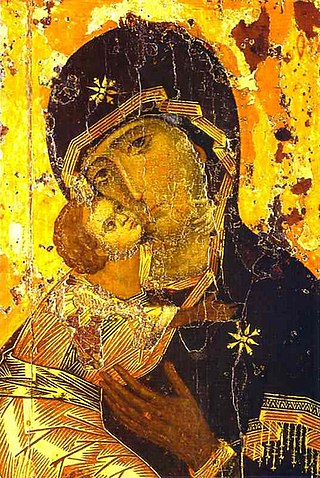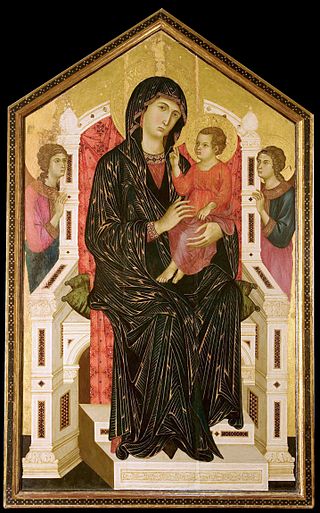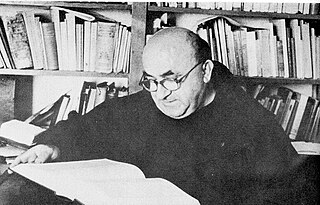Related Research Articles

The Immaculate Conception is the belief that the Virgin Mary was free of original sin from the moment of her conception. It is one of the four Marian dogmas of the Catholic Church. Debated by medieval theologians, it was not defined as a dogma until 1854, by Pope Pius IX in the papal bull Ineffabilis Deus. While the Immaculate Conception asserts Mary's freedom from original sin, the Council of Trent, held between 1545 and 1563, had previously affirmed her freedom from personal sin.

The Feast of the Immaculate Conception celebrates the Immaculate Conception of the Blessed Virgin Mary on 8 December, nine months before the feast of the Nativity of Mary on 8 September. It is one of the most important Marian feasts in the liturgical calendar of the Roman Catholic Church.

Catholic Mariology is Mariology in Catholic theology. According to the Immaculate Conception taught by the Catholic Church, she was conceived and born without sin, hence Mary is seen as having a singular dignity above the saints, receiving a higher level of veneration than all angelic spirits and blessed souls in heaven. Catholic Mariology thus studies not only her life but also the veneration of her in daily life, prayer, hymns, art, music, and architecture in modern and ancient Christianity throughout the ages.

The Minor Basilica of Saint Mary of the Immaculate Conception is a Black Catholic parish in downtown Norfolk, Virginia. It is the oldest parish in the Diocese of Richmond and is known locally as "The Mother Church of Tidewater Virginia".

The Order of the Immaculate Conception, abbreviated OIC and also known as the Conceptionists, is a Catholic religious order of Pontifical Right for nuns founded by Saint Beatrice of Silva. For some years, they followed the Poor Clares Rule, but in 1511 they were recognized as a separate religious order, taking a new rule and the name of Order of the Immaculate Conception.

Ineffabilis Deus is an apostolic constitution by Pope Pius IX. It defines the dogma of the Immaculate Conception of the Blessed Virgin Mary. The document was promulgated on December 8, 1854, the date of the annual Solemnity of the Immaculate Conception, and followed from a positive response to the encyclical Ubi primum.

Mary, the mother of Jesus in Christianity, is known by many different titles, epithets, invocations, and several names associated with places.

Deiparae Virginis Mariae, is an encyclical of Pope Pius XII released in 1946 addressed to all Catholic bishops on the possibility of defining the Assumption of the Blessed Virgin Mary as a dogma of faith.

Fulgens corona is an encyclical by Pope Pius XII, given at St. Peter's, Rome, on 8 September 1953, the Feast of the Nativity of the Blessed Virgin Mary, in the fifteenth year of his Pontificate. The encyclical proclaims a Marian year for 1954, to commemorate the centenary of the definition of the dogma of the Immaculate Conception of the Virgin Mary.

Mariology is the theological study of Mary, the mother of Jesus. Mariology seeks to relate doctrine or dogma about Mary to other doctrines of the faith, such as those concerning Jesus and notions about redemption, intercession and grace. Christian Mariology aims to place the role of the historic Mary in the context of scripture, tradition and the teachings of the Church on Mary. In terms of social history, Mariology may be broadly defined as the study of devotion to and thinking about Mary throughout the history of Christianity.

The theology of Pope Pius XII is reflected in his forty-one encyclicals, as well as speeches and nearly 1000 messages, during his almost 20-year pontificate. The encyclicals Mystici corporis and Mediator Dei advanced the understanding of membership and participation in the Catholic Church. The encyclical Divino afflante Spiritu began opening the door to historical-critical biblical studies. But his magisterium was far larger and is difficult to summarize. In numerous speeches Catholic teaching is related to various aspects of life, education, medicine, politics, war and peace, the life of saints, Mary, the mother of God, things eternal and temporal.

The history of Catholic Mariology traces theological developments and views regarding Mary from the early Church to the 21st century. Mariology is a mainly Catholic ecclesiological study within theology, which centers on the relation of Mary, the Mother of God, and the Church. Theologically, it not only deals with her life but with her veneration in life and prayer, in art, music, and architecture, from ancient Christianity to modern times.

The Mariology of the popes is the theological study of the influence that the popes have had on the development, formulation and transformation of the Roman Catholic Church's doctrines and devotions relating to the Blessed Virgin Mary.
Ad diem illum laetissimum is an encyclical of Pope Pius X on the Immaculate Conception, dated 2 February 1904, in the first year of his Pontificate. It is issued in commemoration of the fiftieth anniversary of the dogma of the Immaculate Conception. The first reason for Pius to write the encyclical was his desire to restore of all things in Christ, which he had defined as his motto in his first encyclical letter. It explains the Mariology of Pius X.

Mariological papal documents have been a major force that has shaped Roman Catholic Mariology over the centuries. Mariology is developed by theologians on the basis not only of Scripture and Tradition but also of the sensus fidei of the faithful as a whole, "from the bishops to the last of the faithful", and papal documents have recorded those developments, defining Marian dogmas, spreading doctrines and encouraging devotions within the Catholic Church.

Ubi primum is an encyclical of Pope Pius IX to the bishops of the Catholic Church asking them for opinion on the definition of a dogma on the Immaculate Conception of the Virgin Mary. It was issued on February 2, 1849.

The Pontifical Academy of Mary is an international pontifical organization tasked with promoting mariology. The academy is one of the Pontifical academies at the Vatican in Rome. The PAMI also has the task of coordinating the other Marian academies and societies that exist worldwide and of exercising vigilance against any Marian excess or minimalism. For this purpose the Pope directed that the Academy have a council that examines the organization of congresses, and that coordinates Mariological societies and those who promote or teach mariology.

In the Catholic Church, several locations around the world invoke the patronage of the Immaculate Conception. Catholic diocesan authorities with the expressed and written approval of the Pope in countries including the United States, Brazil, Korea, the Philippines and Spain designate the Blessed Virgin Mary as their principal patroness.

The Column of the Immaculate Conception is a nineteenth-century monument in central Rome depicting the Blessed Virgin Mary, located in what is called Piazza Mignanelli, towards the south east part of Piazza di Spagna. It was placed aptly in front of the offices of the Palazzo di Propaganda Fide which houses the Congregation for the Evangelization of Peoples, as well as in front of the Spanish embassy as recognition by the pontiff of the defense that this nation has always made of this dogma of faith.

Grotta di Lourdes is an artificial cave in the Vatican gardens. It was built in 1902–05 and is a replica of the Lourdes Grotto in France. The context of building this grotto is the vision of the Madonna that a young girl, Bernadette Soubirous, experienced 18 times. Prior to that the Pope had promulgated the dogma of the Immaculate Conception in 1854.
References
- ↑ Vatican archives – Address by Pope John Paul II (22 October 2002)
- ↑ Living Tradition – The Pontifical Academy of the Immaculata